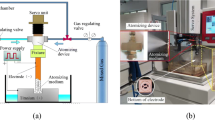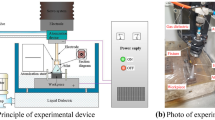Abstract
Electrical discharge machining ablation (EDMA) technology is an EDM processing method that uses oxygen as the discharge medium. Compared with traditional EDM, EDMA can greatly improve the machining efficiency but is prone to combustion and explosion phenomena when machining titanium alloy and cannot obtain stable continuous processing. Therefore, this present first analyzes the oxidation characteristics of titanium alloy from the oxidation thermodynamics and kinetics of the material. Then, the structural characteristics of the oxide layer formed on the surface of the titanium alloy where combustion and explosion phenomena occur are analyzed, and the effects of the metal elements that constitute the titanium alloy on the oxide layer structure are studied to reveal the reasons for the explosions. Finally, a method of mixed-gas electrical discharge ablation processing for titanium alloy to avoid explosions is proposed. The material removal rate in the proposed approach is 10 times and 3.5 times greater than that of conventional nitrogen- and argon-assisted submersed gas-flushing EDM, respectively. This provides a new electric machining technology for the high-efficiency and sustainable processing of titanium alloy.




















Similar content being viewed by others
Availability of data and materials
The data and materials set supporting the results are included within the article.
References
Khan A M, He N, LL, Zhao W, Jamil M (2020) Analysis of productivity and machining efficiency in sustainable machining of titanium alloy. Proc Manuf 43:111–118
Su HH, Liu P, Fu YC, Xu JH (2012) Tool life and surface integrity in high-speed milling of titanium alloy TA15 with PCD/PCBN tools. Chin J Aeronaut 25(5):784–790
Wang F, Liu YH, Zhang YZ, Tang ZM, Ji RJ, Zheng C (2014) Compound machining of titanium alloy by super high speed EDM milling and arc machining. J Mater Process Technol 214:531–538
Oliver H, Zak L, Matthew T, Martin J (2018) The effect of titanium alloy chemistry on machining induced tool crater wear characteristics. Wear 408:200–207
Ming W, Jia H, Zhang H, Zhang Z, Liu K, Du J, Shen F, Zhang G (2020) A comprehensive review of electric discharge machining of advanced ceramics. Ceram Int 46(14):21813–21838
Valaki JB, Rathod PP, Sankhavara CD (2016) Investigations on technical feasibility of Jatropha curcas oil based bio dielectric fluid for sustainable electric discharge machining (EDM). J Manuf Process 22:151–160
Zhang Z, Yu H, Zhang Y, Yang K, Li W, Chen Z, Zhang G (2018) Analysis and optimization of process energy consumption and environmental impact in electrical discharge machining of titanium superalloys. J Clean Prod 198(10):833–846
Singh NK, Pandey PM, Singh KK, Sharma MK (2016) Steps towards green manufacturing through EDM process A review. Cogent Eng 3(1):1272662
Kunieda M, Yoshida M (1997) Electrical discharge machining in gas. CIRP Ann Manuf Technol 46:143–146
Singh NK, Pandey PM, Singh KK (2017) Experimental investigations into the performance of EDM using argon gas-assisted perforated electrodes. Mater Manuf Process 32(9):940–951
Macedoa FTB, Wiessnera M, Hollenstein C, Kustera F, Wegenera K (2016) Investigation of the fundamentals of tool electrode wear in dry EDM. Procedia CIRP 46:55–58
Goiogana M, Flano O, Sarasua JA, Echavarri L (2019) Design and validation of a headstock prototype for dry EDM drilling. Int J Adv Manuf Technol 105(11):295–308
Islam MM, Li CP, Ko TJ (2017) Dry electrical discharge machining for deburring drilled holes in CFRP composite. Int J Precis Eng Manuf Green Tech 4(2):149–154
Li L, Wang Y (2020) Discharge gap and relative discharge ratio in dry electrical discharge machining. Procedia CIRP 95(1):482–487
Roth R, Kuster F, Wegener K (2013) Influence of oxidizing gas on the stability of dry electrical discharge machining process. Procedia CIRP 6:338–343
Liquing L, Yingjie S (2013) Study of dry EDM with oxygen mixed and cryogenic cooling approaches. Proccedia CIRP 6:345–351
Yadav VK, Kumar P, Dvivedi A (2019) Performance enhancement of rotary tool near-dry EDM of HSS by supplying oxygen gas in the dielectric medium. Mater Manuf Process 34(16):1832–1846
Kong L, Liu Z, Qiu M, Wang W, Han Y, Bai S (2019) Machining characteristics of submersed gas-flushing electrical discharge machining of Ti6Al4V alloy. J Manuf Process 41:188–196
Liu ZD, Yin CJ, Chen LH, Qiu MB, Tian ZJ (2014) Efficient combined machining of electrospark-induced controllable combustion and turning dressing for TC4. Mater Manuf Process 29(5):614–620
Xu AY, Liu ZD, Li WP, Tian ZJ, Qiu MB (2014) Study of high-efficiency electrical discharge machining-induced ablation machining of titanium alloy TC4 using a multi-function electrode. Int J Adv Manuf Technol 72:377–385
Kong L, Liu Z, Han Y, Qiu M (2018) Research on the efficient and stable sinking electrical discharge machining ablation process of Ti-6Al-4V. Int J Adv Manuf Technol 97:2151–2161
Kong L, Liu Z, Bai S, Qiu M, Han Y (2019) Investigation on controllable characteristics of electrical discharge ablation of Ti6Al4V. Int J Adv Manuf Technol 105:1645–1654
Kong L, Liu Z, Qiu M, Han Y (2019) Processing factors of controllable die-sinking ablation processing on Ti-6Al-4V. J Manuf Process 39:338–345
Siqi Z, Jinsong H (2006) Nonferrous metal smelting and ingot casting. Chemical Industry Press, Beijing (In Chinese)
Honghai C (1995) Metal corrosion. Beijing University of Technology Press, Beijing, pp 19–60 (In Chinese)
Xiang H, Tan Y-F, Wang X-L, Tan H, Xu T (2015) Effects of nitrogen flux on microstructure and tribological properties of in-situ TiN coatings deposited on TC11 titanium alloy by electrospark deposition. Trans Nonferrous Met Soc China 25(10):3329–3338
Xu AY, Liu ZD, Li WP, Qu MB, Tian ZJ (2014) In-situ synthesis of TiN coating on titanium alloy surface by EDM with functional electrode. J South China Univ Technol Nat Sci 1:11–16 (in Chinese)
Xu AY, Liu ZD (2014) Study of the TiN coating synthesized by EDM of flexible titanium electrode. Trans China Weld Inst 35(2):23–27 (in Chinese)
Yongqing Zh, Lian Z, Ju D, Zhu K, Wang X (2000) Burning behavior of titanium alloys in mixture Ar and O2. Rare Metal Mater Eng 29(5):344–346 (In Chinese)
Yongqing Z, Lian Z, Henglei Q, Huan W, Caili L, Yuelu L (2002) Effects of ambient atmosphere with different flow rates of N2 gas and O2 gas on the combustion behavior of titanium alloys. Proceedings of China Materials Seminar 2:2055–2056 (In Chinese)
Acknowledgements
The authors extend their sincere thanks to those who contributed in the preparation of the instructions.
Funding
This project was supported by the National Natural Science Foundation of China (Grant Nos. 51705040, 51975290).
Author information
Authors and Affiliations
Contributions
All authors have been personally and actively involved in substantive work leading to the report.
Corresponding author
Ethics declarations
Ethical approval
Not applicable.
Consent to participate
Not applicable.
Consent to publish
Not applicable.
Competing interests
The authors declare no competing interests.
Additional information
Publisher's Note
Springer Nature remains neutral with regard to jurisdictional claims in published maps and institutional affiliations.
Rights and permissions
About this article
Cite this article
Kong, L., Lei, W., Han, J. et al. Analysis and research on the causes of the inability to use pure oxygen dielectric discharge ablation process on titanium alloy. Int J Adv Manuf Technol 119, 6103–6118 (2022). https://doi.org/10.1007/s00170-022-08691-6
Received:
Accepted:
Published:
Issue Date:
DOI: https://doi.org/10.1007/s00170-022-08691-6




